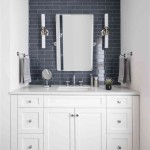How To Paint a Bathroom Tile Floor
Painting a bathroom tile floor can offer a cost-effective and relatively straightforward way to refresh a tired or outdated space without undertaking a full-scale renovation. While not as durable as replacing the tile entirely, a properly executed paint job can significantly improve the aesthetic appeal of the bathroom. The success of the project hinges on meticulous preparation, the selection of appropriate materials, and careful application techniques. This article provides a comprehensive guide to painting a bathroom tile floor, outlining the essential steps and considerations for achieving a professional-looking finish.
Before embarking on this project, it is crucial to understand the limitations of paint on tile. Painted tile is generally less resistant to scratches, chips, and moisture damage compared to unpainted tile or professional tile refinishing. High-traffic areas and areas frequently exposed to standing water will be more prone to wear and tear. With proper preparation and the use of durable epoxy-based paints, the lifespan of a painted tile floor can be extended, but regular maintenance and touch-ups should be anticipated. It is also important to consider the tile's existing condition. Severely damaged or uneven tiles are best addressed through repair or replacement rather than painting.
Key Point 1: Essential Preparation for Painting Tile
Thorough preparation is the cornerstone of a successful bathroom tile floor painting project. The existing tile surface must be impeccably clean, free of any grease, grime, soap scum, or loose debris. Any contaminants will prevent the paint from adhering properly, leading to premature peeling and chipping. The preparation process involves several steps:
Cleaning: Begin by sweeping or vacuuming the floor to remove any loose debris. Follow this with a deep cleaning using a strong alkaline cleaner designed to remove grease and grime. A solution of trisodium phosphate (TSP) or a TSP substitute is highly effective. Follow the manufacturer's instructions carefully and wear appropriate protective gear, including gloves and eye protection. Scrub the tile and grout thoroughly with a stiff-bristled brush or sponge. Rinse the floor multiple times with clean water to ensure all traces of the cleaner are removed. Allow the floor to dry completely, which may take several hours.
Repairing Damage: Inspect the tile floor for any cracks, chips, or loose tiles. Repair any damage before painting. Small cracks can be filled with tile filler or epoxy grout. Larger cracks or loose tiles may require more extensive repair or even replacement. Allow any repair materials to cure completely according to the manufacturer's instructions before proceeding. Uneven surfaces reduce the life span and effectiveness of the paint job.
Sanding: Sanding creates a slightly roughened surface that provides better adhesion for the primer and paint. Use a fine-grit sandpaper (180-220 grit) and lightly sand the entire tile surface. Focus on scuffing the glossy finish to create a matte surface. Pay particular attention to edges and corners. After sanding, thoroughly vacuum the floor to remove any sanding dust. Wipe the floor down with a tack cloth to remove any remaining dust particles.
Etching (Optional): Etching is a process that further roughens the tile surface, improving adhesion. It is often recommended for very smooth or glossy tiles. Tile etching solutions are available at most home improvement stores. Follow the manufacturer's instructions carefully, wearing appropriate protective gear. Apply the etching solution to the tile surface and allow it to sit for the recommended time. Rinse the floor thoroughly with clean water and allow it to dry completely.
Masking: Protect surrounding surfaces, such as baseboards, walls, and fixtures, by masking them off with painter's tape. Apply the tape carefully and ensure it is firmly adhered to prevent paint from bleeding underneath. Consider using drop cloths or plastic sheeting to protect other areas of the bathroom from paint splatters.
Key Point 2: Choosing the Right Paint and Primer
Selecting the appropriate paint and primer is critical for achieving a durable and long-lasting finish. Standard wall paint is not suitable for bathroom tile floors, as it lacks the necessary durability and moisture resistance. The ideal choice is a two-part epoxy paint specifically designed for tile or a specialized tile paint.
Epoxy Paint: Epoxy paint offers excellent adhesion, durability, and moisture resistance. Two-part epoxy paints are mixed together before application, creating a hard and durable finish. These paints are typically more expensive than other options but provide superior performance. When choosing epoxy paint, select a product specifically formulated for tile surfaces. Follow the manufacturer's instructions carefully regarding mixing ratios and application techniques. Epoxy paints often have a limited pot life, so only mix the amount you can apply within the specified timeframe.
Tile Paint: Specialized tile paints are also available, often marketed as "tile refinishing kits." These kits typically include a primer and topcoat specifically designed for bonding to tile surfaces. While generally easier to apply than epoxy paints, they may not offer the same level of durability. Read product reviews and choose a reputable brand known for its quality and performance.
Primer: A high-quality primer is essential for promoting adhesion between the tile surface and the paint. Choose a primer specifically designed for use on tile or glossy surfaces. Epoxy primers are generally recommended for use with epoxy paints, while acrylic or latex primers are suitable for use with tile paints. Apply the primer according to the manufacturer's instructions, ensuring a thin, even coat. Allow the primer to dry completely before applying the paint. A second coat of primer may be necessary for particularly smooth or glossy tiles.
Color Selection: Consider the existing décor of the bathroom when choosing a paint color. Light colors can brighten a small space, while darker colors can add drama and sophistication. Be aware that lighter colors may show dirt and stains more easily. Test a small area of the tile with the chosen paint color to ensure it complements the rest of the bathroom.
Key Point 3: Application Techniques and Curing
Proper application techniques are essential for achieving a smooth, even, and durable finish. The application process typically involves applying multiple thin coats of paint, allowing each coat to dry completely before applying the next.
Application Tools: Use high-quality brushes, rollers, and paint trays designed for use with epoxy or tile paints. Foam rollers are often preferred for achieving a smooth, even finish. Avoid using cheap brushes or rollers, as they may leave streaks or shed bristles. Prepare the application tools by cleaning them thoroughly before use.
Applying the Paint: Start by "cutting in" around the edges of the room with a brush, carefully painting along the masked-off areas. Then, use a roller to apply the paint to the rest of the floor. Apply the paint in thin, even coats, overlapping each stroke slightly to avoid leaving any gaps. Avoid applying the paint too thickly, as this can lead to drips, runs, and uneven drying. Allow each coat of paint to dry completely according to the manufacturer's instructions. This may take several hours or even overnight.
Multiple Coats: Apply at least two coats of paint for optimal coverage and durability. For high-traffic areas, consider applying three coats. Lightly sand the floor with fine-grit sandpaper between coats to smooth out any imperfections and improve adhesion. Be sure to remove all sanding dust before applying the next coat of paint.
Grout Lines: Consider using a grout pen to touch up the grout lines after painting. This can help to create a cleaner, more defined look. Choose a grout pen color that complements the paint color or matches the original grout color.
Curing: Allow the painted floor to cure completely before using the bathroom. Curing is the process by which the paint hardens and reaches its full durability. The curing time typically ranges from several days to a week, depending on the type of paint used. Follow the manufacturer's instructions regarding curing time. Avoid walking on the floor or placing any heavy objects on it during the curing process. Protect the floor from moisture and humidity during curing.
Maintenance: Once the paint has cured, maintain the painted tile floor by cleaning it regularly with a mild detergent and water. Avoid using harsh chemicals or abrasive cleaners, as these can damage the paint. Use a soft cloth or mop to clean the floor. Immediately wipe up any spills to prevent staining. Consider placing rugs or mats in high-traffic areas to protect the paint from wear and tear. Be prepared to touch up any chips or scratches as needed. Regular maintenance will help to extend the lifespan of the painted tile floor.
In addition to the above, it's prudent to consider the ventilation in the bathroom. Ensure proper ventilation during the painting process to minimize exposure to paint fumes. Open windows and use a fan to circulate air. Wear a respirator mask to protect yourself from inhaling paint fumes. If you are sensitive to paint fumes or have respiratory problems, consider hiring a professional to paint the floor.
Furthermore, review and understand all safety data sheets (SDS) for all of the products being used. These sheets provide information on the potential hazards associated with the products and the necessary precautions to take. Store paint and other materials properly, away from heat, sparks, and open flames. Dispose of leftover paint and empty containers according to local regulations. By following these safety precautions, you can minimize the risk of accidents and injuries during the painting process.

How To Paint Your Bathroom Floor Tile Young House Love

How To Paint A Tile Floor Artsy Rule

Diy How To Paint Ceramic Floor Tile Farmhouse Living

How To Paint Your Bathroom Tile Floors Toolbox Divas

How To Paint Tile Floor In A Bathroom Angela Marie Made

How To Paint Tile Floor Angela Marie Made

How To Paint Bathroom Tile Floors

How To Paint Bathroom Tile Floor Shower Backsplash Painting Tiles

Painted Floor Tile Bathroom Makeover

20 Painted Tile Floor Ideas To Update Your Space Making Maanita
Related Posts







